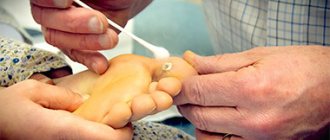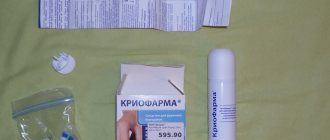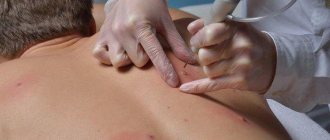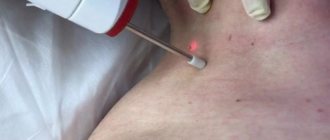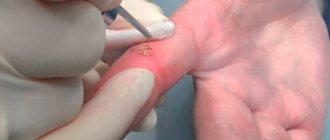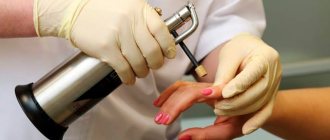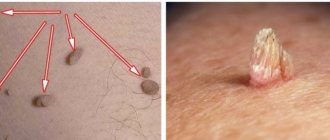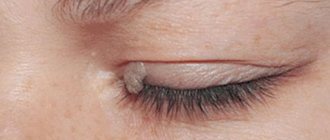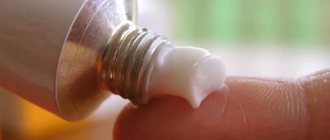Papillomas can be localized in any area of the skin. The most common places for the localization of benign neoplasms of the skin and mucous membranes are the skin of the folds of the neck, axillary zones, inguinal-femoral folds and pubis, genitals and gluteal folds, and perianal zone. This is due to the fact that in these places the skin is most susceptible to friction and the appearance of microtraumas, through which the human papillomavirus (HPV) enters from an infected environment.
The source of HPV infection is a sick person (through direct bodily or sexual contact) and objects contaminated with the virus (towels, washcloths, razors).
The incubation period of human papillomavirus infection ranges from two weeks to several years.
It is also possible that papillomas may appear on the mucous membranes of the lips and mouth, nose, external genitalia, vagina and cervix. With HPV infection of the cervix, dysplasia occurs - changes in the cellular composition of the mucosa, which increases the risk of cervical cancer. There are several dozen varieties of HPV, oncogenic - papillomavirus types 16 and 18, which can be identified by DNA testing (PCR) of a cervical scraping.
In appearance, papillomas on the skin look like neoplasms that protrude above the skin level in the form of hemispherical flat nodules or threads of soft and moderately dense consistency ranging in size from 1 mm to 5–7 mm. Neoplasms can have a “thin stalk” or a wider base. Papillomas usually have the color of the surrounding skin, sometimes there is a pink tint in the lesions.
Papillomas in the area of the external genitalia are called genital warts. They are transmitted through intimate contact (a condom does not always protect against this infection). Condylomas acuminata have the appearance of pink soft elastic formations on a thin stalk with a papillary surface, reminiscent of the appearance of a “cockscomb” or “cauliflower”.
The size of condylomas usually does not exceed 5 mm, but when several elements group and merge, foci of condylomatosis with sizes up to several centimeters are formed.
Operating principle
Cryodestruction of papillomas - this is the name of this method - is a procedure for removing unwanted growths by exposing the neoplasm tissue to low temperatures.
How does the removal procedure work - cauterization of papilloma with liquid nitrogen?
What are the consequences of this method? Are there any contraindications and can this procedure be performed independently at home? Let's consider these questions in detail.
Burning of papillomas is carried out with liquid nitrogen, which, due to its characteristics at low temperatures, can have a destructive effect on soft tissue . This property of gas is effectively used in medicine today, displacing other chemical and less safe agents.
Freezing of papillomas is carried out manually by a specialist, by applying the product with an applicator to the damaged area, using special equipment, and it is also possible to process it yourself at home using specialized drugs offered for sale in the pharmacy chain.
Liquid nitrogen has been used for unwanted growths for quite some time.
What is cryodestruction in principle, what is the basis of the method, what application is most effective?
To begin with, we note that the main reagent is a component of air, so this method is considered the most environmentally friendly and free of harmful substances. Having separated the gas, they use its ability to liquefy at low temperatures, as well as its ability to destroy soft tissue.
After the tumor is cauterized with liquid nitrogen, slight swelling of the adjacent area or a small bubble filled with liquid may form.
If we talk about the effectiveness of any of the methods, then the difference between the methods lies in the method of application and only, the active substance is the same in all cases.
Another issue is the accuracy of application. When performing the procedure, the specialist tries to capture as little healthy tissue as possible to prevent it from being burned. Application with an applicator is less accurate than with the use of specialized equipment. Use at home and its safety depends on the careful use of the drug yourself.
Cryotherapy involves the use of the drug by medical institutions, as well as removal independently, using special means.
Cryosurgery is an effective method in the treatment of manifestations of HPV activity, allowing the removal of neoplasms by cryodestruction.
To relieve pain during the cold papillomas removal procedure, local anesthesia is sufficient.
Cryotherapy is one of the most popular types of therapy, since cryodestruction does not cause the appearance of grams or scars after the procedure, and the rehabilitation period does not take much time.
Neoplasms that appear as a result of the activity of papillomaviruses are very often cauterized using liquid gas because the method is painless and safe.
Even if there is no opportunity or need to visit a medical or cosmetic institution, you can get rid of growths using a drug that has identical freezing properties; freezing and, as a result, removal of the tumor can be done at home.
The areas of the skin where the application occurs die off under the influence of the cryogenic properties of the active substance.
Cryodestruction of papillomas has a large number of positive reviews about the use of therapy
Who is indicated for cryodestruction of papillomas?
Before deciding on your own whether the procedure is necessary, you must visit a doctor - a dermatologist or oncologist. The doctor will write a referral for examination, assess the type of tumor and develop a treatment strategy.
The danger of HPV lies in the fact that the neoplasms that the virus causes are often carcinogenic in nature and cause cancer of the skin and mucous membranes. For most patients, it will not be enough to simply remove the growth on the body - they will need complex treatment for HPV, including taking pharmaceuticals.
List of indications for removal of tumors using the cryomethod:
Shallow papilloma
The presence of rapidly growing formations over a large area;- The growths are located in those areas of the body that are subject to constant friction and can be accidentally damaged (neck, fingers);
- Papillomas, accompanied by bleeding and inflammatory processes, causing severe pain;
- Neoplasms formed as a result of taking hormonal medications or reduced immunity.
If a patient notices a large number of papillomas on his skin, the number of which is increasing every day, he should immediately consult a doctor.
Important! It is strictly prohibited to remove the growth yourself - this can provoke even greater growth of tumors and lead to unpredictable consequences.
Advantages and disadvantages
Cryodestruction of papillomas has a large number of positive reviews about the use of therapy.
Removing papillomas that appear on the skin with cold practically does not imply the appearance of scars after cauterization.
You can remove papilloma with nitrogen in various ways - at home or with the help of medical specialists , as well as beauty salons, the price of each option will be different, it depends on the method of implementation (hardware or manual), the cost of the drug, and additional funds.
Your doctor can advise you where to remove tumors with liquid nitrogen.
Special products can be prescribed to treat the skin at home; cryodestruction is increasingly being carried out by patients on their own.
A can of medicine is bought at a pharmacy, you can buy it without a doctor’s prescription, the active ingredient is liquid gas. It must be remembered that before you start using it, you must study the contraindications listed in the instructions for the drug.
How long does the procedure take?
The first application usually lasts no more than 5 seconds. After the tumor is cauterized with liquid nitrogen, slight swelling of the adjacent area or a small bubble filled with liquid may form.
Despite the fact that removing growths with liquid nitrogen is available at home, the removal procedure can lead to certain complications. Liquid nitrogen for removing papillomas, which can be bought at a pharmacy, is equally active as that used by specialists, so there is a danger of burning healthy tissue; you must strictly follow the instructions for the procedure.
In intimate places, the use of the drug should be entrusted to an experienced specialist to avoid burns to the mucous membrane when burning out the tumor.
To select a suitable location for the procedure, you can study the available reviews and recommendations; cryodestruction itself has positive reviews due to the safety of the method when used properly, as well as its natural composition.
Is it possible to remove papillomas with a drug such as cryopharma?
This product is sold in a pharmacy, the use of which is possible without the participation of a specialist, but it is better to clarify this issue with a doctor before use.
Is it painful to cauterize tumors with nitrogen?
Pain may be present during the procedure, especially if the infected area is quite large. In this case, local anesthesia is used.
Regardless of the means by which cryodestruction is carried out, the composition, which includes liquid nitrogen, has a destructive effect on soft tissues, therefore the papilloma is burned out, but if it comes into contact with healthy skin it causes a burn; you need to be extremely careful when using such products yourself.
Pain may be present during the procedure, especially if the infected area is large enough
Additional measures
Cryotherapy is not a panacea for the treatment of papillomas. Neoplasms may reappear on the same or another part of the body, since external methods do not affect the main causative agent of the disease - the human papillomavirus. To suppress HPV, lifestyle adjustments are carried out (it is recommended to quit smoking, increase physical activity, strengthen the immune system) and treatment with drugs for internal use. Freezing papillomas eliminates only the external manifestation of the virus.
In order to avoid relapse, you should undergo an examination and identify the cause of the proliferation of papillomas. For complex treatment, combination therapy is used. Before outpatient and home manipulations, you must make sure that the neoplasm is benign.
Indications and contraindications
Cryodestruction of papillomas is indicated for patients with pathological neoplasms caused by HPV activity.
Burning out papillomas with liquid nitrogen is not performed on patients with diagnosed cancer, impaired functioning of the cardiovascular system, hypertension, or presence of rashes in the area to be treated.
Burning papillomas with nitrogen is also prohibited during pregnancy.
If you have doubts whether to cauterize the tumors or not, whether it is possible to use a drug with nitrogen, then it is better to coordinate the use with a specialist
Cauterization with liquid nitrogen may have other contraindications, for example, if the doctor reveals that you have individual nitrogen intolerance.
Treatment with nitrogen should only be carried out if all possible contraindications are absent.
If you have any doubts whether to cauterize the tumors or not, or whether it is possible to use a drug with nitrogen, then it is better to coordinate the use with a specialist.
What are papillomas
Papillomas (warts) are benign neoplasms located on the skin or mucous membranes. They look like a small spherical growth on a thick base or stalk and have a soft consistency. Usually the size of warts does not exceed 1-2 cm. The surface is uneven. The color can vary from flesh to dirty brown.
Papillomas can be either single or multiple. Several adjacent formations can merge with each other, as a result their surface takes on a bizarre shape, reminiscent of a cauliflower inflorescence or a cockscomb.
In the presence of multiple papillomas, the disease is called papillomatosis.
How does deletion work?
As a rule, removal of papillomas by cryodestruction is performed by a medical or cosmetic specialist.
Removal of the growth with liquid nitrogen occurs by applying the active substance directly to the area of growth using an applicator or special equipment.
At home, the use of removal drugs, such as cryopharma, occurs in accordance with the instructions.
How removal occurs and the duration of exposure to the reagent is determined individually depending on the severity of the disease. Complications are possible during therapy, so you should follow the instructions very carefully.
Side effects
The first stage involves freezing the affected tissue. Swelling, blistering, and paralysis may form on the eyelids, lips, and other parts of the body. Complete removal and healing of the scar can take up to six months.
The cryodestruction method is not well tolerated by all patients. People with sensitive skin may experience blisters filled with blood. You cannot pierce them yourself; this procedure is carried out by a doctor with a sterile needle and a bandage is applied. In this case, tissue healing should be expected within 1-2 weeks.
Care after removal
The papilloma dies after cauterization. The area of the procedure needs care, especially if there is swelling or other reactions (bubbles, redness).
The damaged tissue should be treated with anti-inflammatory and decongestant drugs. The attending physician will advise you in detail on how to treat the ulcers after cauterization of the tumor.
After removal with nitrogen, if there are no contraindications, then possible complications are minimal.
The rehabilitation period varies depending on the severity of the disease and the location of the formations. On average, with the standard course of the process and proper care of the postoperative area, the rehabilitation period takes from 7 to 14 days.

